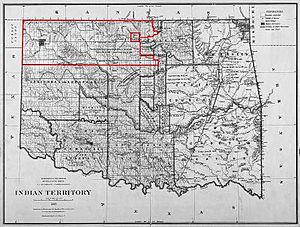Cherokee Outlet facts for kids
The Cherokee Outlet, often called the Cherokee Strip, was a large piece of land in what is now the state of Oklahoma in the United States. It was about 60 miles (97 km) wide and stretched between the 96th and 100th lines of longitude. This land was south of the border between Oklahoma and Kansas.
Contents
What Was the Cherokee Outlet?
The Cherokee Outlet was a huge area of land that belonged to the Cherokee Nation. Imagine a long, wide strip of land, like a giant hallway, that was set aside for a specific purpose. This land was important for the Cherokee people and for the history of Oklahoma.
How the Cherokee Nation Got the Land
The Cherokee Nation, a Native American tribe, originally lived in the southeastern United States. But in the 1830s, the U.S. government forced them to move west to what was called Indian Territory (which later became Oklahoma). This difficult journey is known as the Trail of Tears.
When they arrived in Indian Territory, the Cherokee Nation was given a large area of land. Part of this land was the Cherokee Outlet. They received this land through treaties, which are official agreements between governments. The U.S. government promised the Cherokee Nation this land forever.
Why Was it an "Outlet"?
The land was called an "Outlet" because it gave the Cherokee Nation access to hunting grounds in the west. It was like a pathway or a corridor that allowed them to reach other areas for hunting and trading. This was important for their way of life.
The Importance of Cattle Trails
Even though the land belonged to the Cherokee, it became very important for American settlers too. After the American Civil War, cattle ranching grew in Texas. Ranchers needed a way to move their cattle north to markets and railroads in Kansas.
Many famous cattle trails, like the Chisholm Trail, passed right through the Cherokee Outlet. Cowboys would drive huge herds of cattle across this land. The Cherokee Nation charged fees to the ranchers for using their land. This was a way for the Cherokee to earn money from their property.
Jesse Chisholm and the Chisholm Trail
One important person connected to these trails was Jesse Chisholm. He was a mixed-blood Cherokee who helped create some of the first routes for moving goods and later cattle. The famous Chisholm Trail was named after him because he helped mark out parts of it. It became one of the most important routes for cattle drives.
The Opening of the Cherokee Outlet
Over time, more and more settlers wanted to move west and claim land. The U.S. government began to pressure Native American tribes to sell parts of their land. This happened with the Cherokee Outlet.
The Land Runs
In the late 1800s, the U.S. government bought the Cherokee Outlet from the Cherokee Nation. This opened the way for one of the most famous events in Oklahoma history: the Land Run of 1893.
On September 16, 1893, a huge area of the Cherokee Outlet was opened for settlement. Thousands of people, called "Boomers" and "Sooners," lined up at the borders. When the signal was given, they rushed into the land to claim their own piece of property. People rode horses, wagons, and even ran on foot to stake their claims.
What Were "Sooners"?
Some people cheated in the land runs. They would sneak onto the land "sooner" than the official start time to hide and claim the best spots. These people became known as "Sooners," and that's where Oklahoma gets its nickname, "The Sooner State."
The Impact of the Land Run
The Land Run of 1893 quickly transformed the Cherokee Outlet. Towns popped up almost overnight, and farms were established. This event played a huge role in the settlement and development of Oklahoma, leading to it becoming a state in 1907.
The Cherokee Outlet, once a hunting ground and a cattle trail, became a place where thousands of new homes and communities were built. It's an important part of the story of how Oklahoma was settled.
Images for kids






